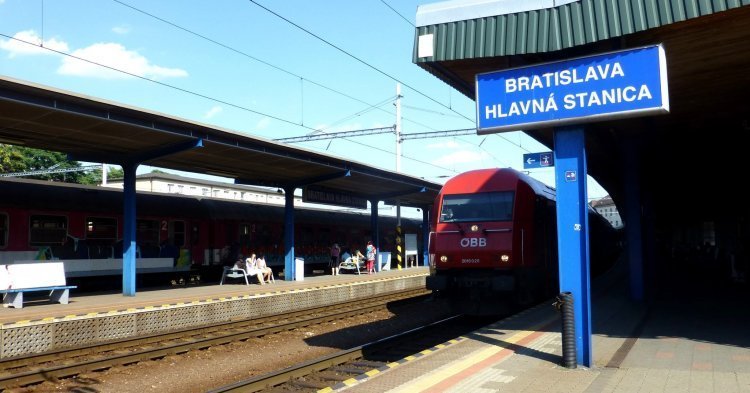It has become a kind of folklore to announce bombastic cooperation plans after every summit with the Chinese premier. All remained the same also after the Sofia summit between China, and Central and Eastern Europe (the “16+1 platform”) in July this year.
Following the bilateral summit with Li Keqiang, Slovak Prime Minister Peter Pellegrini announced plans for how Slovakia is going to profit from relations with China. Construction of a broad-gauge railway, food exports to China, reduction of tariffs on cars produced in Slovakia, or Slovakia’s role as an investment and postal hub were among the major projects mentioned by Pellegrini. However, a realistic and detached scrutiny reveals that these plans are bringing nothing new or significant for Slovakia.
Fico set the tone for bilateral relations a decade ago
Many of the proclamations made by Slovak representatives today echo the tone set by the then-fresh Prime Minister Robert Fico during his visit to China in 2007. Back then, Fico described China as a new source of investments and destination for Slovak exports. According to him, an active economic diplomacy was to yield results in a few years.
The results promised by Fico have never quite materialised. Chinese investments in Slovakia are minimal and Slovak exports to China have been at best stagnating in the past few years. With that being said, this doesn’t mean that certain economic exchanges with China are not profitable and won’t grow in the future. However, to think that all of a sudden China is going to become a key economic actor in Slovakia is as naïve today as it was ten years ago.
Infrastructure projects with Chinese characteristics
The extension of the broad-gauge railway through the territory of Slovakia all the way to the Austrian borders is probably the most symbolic project of cooperation with China in Slovakia. It fits with the exotic image of China as a country investing in infrastructure development all over the world, wherever there is a lack of interest from ‘traditional’ investors.
The proposed broad-gauge railway project would have a great impact on Slovakia’s public finance (according to Pellegrini, between 7 and 8 billion EUR). Right after meeting with Li, Pellegrini stated that China “has interest” in the project. Question remains whether Slovakia is or should be interested in it as well. In other words, is the construction of the broad-gauge railway truly in the interest of Slovakia and if so, how?
Contrary to popular belief, six years of the 16+1 platform’s existence showed that the Chinese offer in this regard is not interesting for EU member states, nor is it in compliance with EU law.
China prefers to pursue construction projects based on direct agreements with other governments. Such agreements tend to include provisions on credit lines with state guarantee of repayment, more or less direct selection of Chinese contractors, which usually use Chinese materials and labour.
Such a proposition is problematic in many respects. Construction projects in EU (as well as many other non-EU countries) require public calls for tenders, in which the most suitable contractor is selected in a transparent manner based on specific criteria.
China attempts to circumvent public contracting regulations by including the requirement to use Chinese contractors in the terms of the credit line.
Secondly, the very form of financing China offers is problematic. China usually offers credit lines to finance the projects. Thus, it is neither an investment nor a grant. Moreover, Chinese interests tend to be relatively high (for the standards of the developed world), typically over 3%. While this offer can potentially be interesting for high-risk and/or poor countries that lack alternatives, it is simply not lucrative for EU members.
Member states of the EU usually are able to borrow money for a much lower interest. In many cases such financing can be obtained even for free from EU structural funds.
The third problematic aspect concerns the project realisation phase. Engaging Chinese firms, and using Chinese materials and labor can reduce the price of the whole project, but inevitably leads to outflow of state capital from the country. State expenditure thus loses its multiplication function since the money won’t continue to circulate in the national economy and generate further spending.
Reputation of Chinese projects
Lately many Chinese infrastructure projects came under the global spotlight. In Sri Lanka, a Chinese-financed airport and harbor led to the local government’s defaulting on repayments. To settle the debt, Sri Lanka leased the two pieces of strategic infrastructure to China for 99 years.
In Ethiopia, the newly built railway is only scarcely used. Chinese plans to reconstruct the railway connecting Budapest with Belgrade are often marked as a flagship of cooperation with Central and Eastern Europe. The project is facing increasingly more complications and it is doubtful whether and how it will be completed.
Moreover, media often report on cases of corruption in decision-making processes around these projects. To what extent Slovak representatives, including PM Pellegrini, realise these risks is questionable.
Limits of Slovak export to China
Proclamations on Slovak exports to China are of a very different nature than the broad-gauge plans. We have been hearing about similar plans for a long time now, but without any fruition. Even if the plans are successfully executed, there are doubts whether this will have any relevant and lasting benefits for Slovakia.
Cars and food products are quite specific. Cars represent the largest portion of Slovak exports to China. Following the global financial crisis, Slovak exports to China were increasing thanks to the growth of car exports. The announced reduction of Chinese tariffs will thus necessarily have an impact on Slovak economy.
In short term, tariff reduction can address the problem that exports to China are stagnating. For the long term prognosis, however, we need to understand that China is building its own car production capacities. The quality of domestic Chinese carmakers is improving rapidly. Many foreign manufacturers also locate their plants in China. Thus, we need to ask for how long it will remain profitable to transport cars on such a long distance.
The situation with food products is debatable for a different reason. Firstly, food production and agriculture as such are marginal sectors of the Slovak economy when it comes to their contribution towards overall GDP and employment. They are also marginal as a component of overall Slovak exports, and China and Asia are no exceptions.
Secondly, the Slovak producers have rather small capacities to satisfy the large Chinese market. Only very few producers are capable to supply goods to China in a sufficient quantity.
Thirdly, as was hinted at by Pellegrini, China does not allow imports of most of the foods from Slovakia. In case of some products, the certification process was commenced, but so far none have been certified.
At least since 2012, China has been declaring its willingness to deal with the tremendous trade imbalance with Slovakia and other Central and Eastern European countries. However, during the six years of 16+1 platform the situation got even worse. Notwithstanding the organisation of trade expos, there are no credible attempts on China’s part to really deal with this problem by opening its own market.
Neither a bridge, nor a gate
One of the most popular manners of speech about cooperation with China is to present Central Europe as a regional investment hub, a gate to Europe, or a bridge between the East and the West.
Virtually each of the 16 countries of Central and Eastern Europe that partake in the summits use such phrases in their own narratives. Thus Slovakia is in no way special in voicing similar metaphors. Truth be told, it even lags in many ways behind its counterparts.
Major transportation routes from China to Western Europe bypass Slovakia at the moment. Railways go primarily through Russia to Poland and Germany. With great pomp, a first train originating from China arrived in Slovakia last year. Despite great plans for establishing a direct trade route between China and Slovakia, no further trains stopped in the country. Currently, trains only pass through on their way to other European countries.
Another route used by China runs from Greece and other Adriatic harbours through Hungary to Austria. Thus in this case Slovakia is largely left out and serves as neither a bridge, nor a gate.
A misplaced notion of an investment ‘hub’
The idea of Slovakia as an investment hub sounds even less realistic. For reasons unknown, Central and Eastern European countries believe that Chinese investors will expand to Western Europe through them.
This idea is ludicrous. Chinese investors have been present to the west of Slovakia for years. The gap between the stock of Chinese investments in Western Europe and the 16 countries has even widened since the establishment of the 16+1 platform. Chinese investors simply understand Western Europe better. Central and Eastern Europe remains a great unknown for Chinese companies, as they do not know what to expect of post-communist states that are now part of EU and NATO, but still differ in many political, economic, and societal aspects from their western counterparts.
At the same time, many of the Central and Eastern European countries do not really offer that many investment opportunities for the Chinese. China for the most part is not searching for locations where to base its own production, servicing, or research capacities. In the developed world, China attempts to gain access to top-notch technologies and brands; in the developing world access to raw materials and infrastructure building projects. In Chinese eyes, Central Europe stands somewhere in between the two, with an unclear potential and little-known environment.
Realistic expectations
For sure, Chinese presence in Slovakia will be growing. Even though big Chinese projects were not carried out in Slovakia, Chinese companies almost acquired the largest TV station (Markíza) and one of the largest employers in the country (U.S. Steel Košice).
China is one of the largest importers to Slovakia. Also, a portion of Slovak exports to Western Europe, especially Germany, end up re-exported to China.
Yet to be realistic, first and foremost, we need to understand Chinese approach in order to be able to distinguish real developments from constructed exotic notions.
We need to formulate a sober policy approach, which will not operate with naïve metaphors of expecting economic aid, even salvation from China, but one that will nevertheless recognise the increasing relevance of China for Slovakia and its growing importance as a world player.
Results brought back home from Sofia by Slovak representatives show that we are still not moving in this direction.



Follow the comments: |
|
